System Buyers' Guide: PCs for Under $1000
by Sean Hollister on February 12, 2010 2:00 AM EST- Posted in
- Guides
AMD Entry-Level PC
Even as Intel produces the fastest desktop processors in the world, it is competitor AMD that has become synonymous with value. Under the $125 price point that Intel has set with the Core i3-530, AMD reigns supreme in both performance and raw core count for every dollar spent. Because of that, for the first time in an AnandTech Buyer's Guide, you'll find us recommending a triple-core processor for an entry-level machine.
| AMD Entry-Level System | ||
| Hardware | Component | Price |
| Processor | AMD Athlon II X3 435 Rana (Tri-core 2.9GHz, 45nm, 3x512KB L2 Cache, Socket AM3) |
$75 |
| Cooling | CPU Retail HSF | $0 |
| Video | Onboard | $0 |
| Motherboard | ASRock M3A785GMH/128M AM3 Micro ATX | $77 |
| Memory | G.Skill Ripjaws 4GB DDR3-1600 F3-12800CL9D-4GBRL | $105 |
| Hard Drive | WD Caviar Blue 500GB WD5000AAKS | $54 |
| Optical Drive | Sony Optiarc Model AD-7240S-OB 24X DVDRW SATA | $28 |
| Audio | Onboard | $0 |
| Case | Cooler Master Centurion 5 CAC-T05-UW Mid Tower ATX | $55 |
| Power Supply | OCZ ModXStream Pro 500W ATX12V SLI Certified, CrossFire Ready, 80 PLUS Certified Modular Active PFC (before $25 Rebate) | $65 |
| Base System Total | $459 | |
| Display | ASUS VW193TR Black 19" 5ms Widescreen LCD (1440 x 900) | $120 |
| Speakers | Built-in Monitor | $0 |
| Input | Microsoft B2L-00045 Comfort Curve Black USB Keyboard and Optical USB Mouse - OEM | $22 |
| Operating System | Microsoft Windows 7 Home Premium OEM 1-Pack (for System Builders) | $105 |
| Complete System Total | $706 | |
| Plus Estimated Shipping (within Continental U.S.) | $717 | |
| Rebates | -$25 | |
| Bottom Line (less tax, if applicable) | $692 | |
And what a processor it is: the 2.9GHz Athlon II X3 435 Rana. Here's the 435 Rana slaughtering last year's value CPU choice, the Athlon X2 7750 BE:
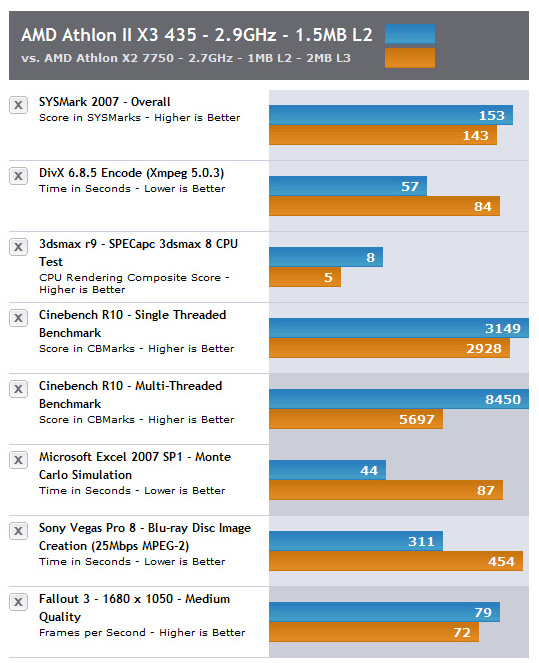
And here's the 435 Rana coming out ahead in every single benchmark against our choice for the Intel entry-level PC, the Pentium Dual-Core E5300:
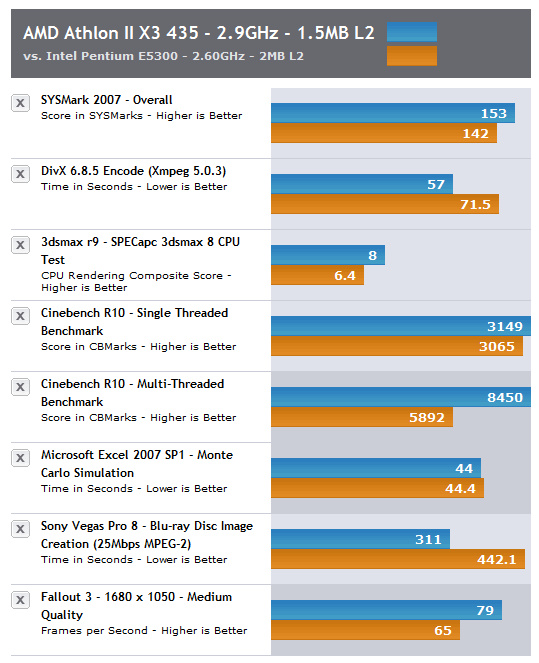
Positioned precisely at the sweet spot in AMD's lineup between the dual-core Athlon II X2s and the quad-core Athlon II X4s, the $75 Athlon II X3 435 Rana has the core count and clock speed to be the best of both worlds. It performs so admirably in both single and multi-threaded applications, in fact, as to give even low-end Phenom II CPUs a run for their money in certain benchmarks. Factor in low enough heat and power consumption that many report overclocking to 3.6GHz on air, and you have a practically perfect processor for budget enthusiasts.
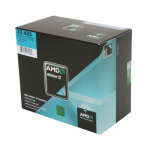 |
And because the 435 Rana is based on the Phenom II die, we just had to pair it with an ACC-capable motherboard. In case you're not familiar, AMD's tri-core chips actually aren't; they're quad-core CPUs binned as having a manufacturing defect in one core with that core consequently disabled. But if demand for a tri-core chip is high enough that AMD finds themselves having to disable perfectly good quad-core chips to sell them as tri-core instead… you just might be able to unlock that fourth core, and ACC (Advanced Clock Calibration) is your golden ticket.
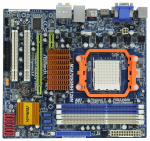 |
But ACC is hardly the best reason to buy the ASRock M3A785GMH/128M motherboard. The reason to buy the M3A785GMH is because for the bargain price of $77, it's one of the most full-featured Micro ATX motherboards we've seen for AMD chips. Based on the AMD 785G / SB710 chipset we favorably reviewed in August, the M3A785GMH is its most powerful interpretation—the one that comes with 128MB sideport of DDR3-1333 for enhanced video performance on its Radeon HD 4200 IGP and supports up to 16GB of DDR3-1600 system memory in four dual-channel banks. The SB710 Southbridge provides five SATA 3Gb/s ports supporting RAID 0, 1 and 10, while Realtek pulls double-duty providing 7.1-channel HD audio with their ALC888 chip and Gigabit Ethernet with their 8111DL NIC. VGA, DVI and HDMI video-out accompany an eSATA, combo PS/2, optical S/PDIF-out and four USB 2.0 ports on the rear panel, with headers for an additional six USB ports on the motherboard itself. Last but not least, a single PCIe x16, a PCIe x1 and two PCI slots appear in an excellent layout with three fan headers, an IDE slot and even a legacy floppy connector at the very bottom. If you don't feel you need the extra speed and future-proofing that comes with DDR3, you can easily shave off $12 by going with the practically identical $65 ASRock A785GMH/128M instead, which trades the Realtek ALC888 for VIA VT1708S 7.1-channel audio and an extra SATA 3GB/s port.
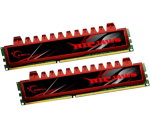 |
With both DDR2 and DDR3 memory prices the highest we've seen in recent memory, picking a set of fast, reliable yet inexpensive modules can be an exercise in futility. Be sure to shop around, because in all likelihood, there will be better and vastly different deals by the time you read this guide. But as of today, we believe the $105 G.Skill Ripjaws 4GB DDR3-1600 CAS 9 kit offers the best value for your money. It's true that regardless of brand and binning, the quality of memory modules varies widely, but G.Skill modules have an excellent reputation as of late, and these particular modules are designed to both run at low voltage (1.5v) and are reportedly excellent overclockers. As mentioned above, if you choose to go the DDR2 route you'll lose some overhead and future-proofing potential, but at a substantial savings of up to $30 if you choose low-cost DDR2 modules like the G.Skill DDR2-800 CAS5.
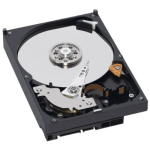 |
While the quality and reliability of magnetic hard drives increases year after year, we've found that actual hard drive capacity and performance is something of a commodity these days. Regardless of the manufacturer you pick today, an entry-level 500GB hard drive will cost you around $55 and offer the same performance as any of its brethren. The only exception to the rule is the WD Caviar Green, which tends to run slightly slower but quieter than its counterparts. Our current pick is the WD Caviar Blue, simply because of its widespread availability and Western Digital's stellar reputation.
Our choice for an optical drive remains the tried-and-true Sony Optiarc AD-7240S-0B, a SATA-connected 24X DVDRW with faster burning speeds and greater reliability than anything else in its price range. Though the price of Blu-ray readers has fallen considerably—the Lite-ON iHOS104-06 in particular retailing for only $60—Blu-ray is still a luxury for most budget boxes, its discussion better saved for our upgrade section on page 6.
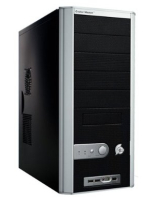 |
If we had to pick a single reason why low-end PCs get a bad rap, it would probably be the prevalence of cheap cases and even cheaper bundled power supplies. To combat these weaknesses, we chose the time-honored favorite Cooler Master Centurion 5 to house these budget PCs, and the OCZ ModXStream 500W PSU to power them. At $55, the Centurion 5 is a solid, stylish aluminum mid-tower with clean lines, few sharp edges, a pair of quality fans, a CPU air duct and a nearly tool-less design that makes installing drives and expansion cards quite easy. Meanwhile, the ModXStream 500W is a bona fide bargain at $40 after rebate, offering efficiency through both reduced power consumption (as certified by the 80 Plus efficiency rating) and a modular design that allows for reduced cabling and, by extension, greater airflow.
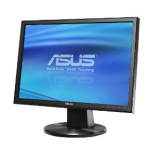 |
Though ASUS is known primarily as a manufacturer of motherboards, in recent years they've expanded their efforts greatly to include netbooks, sound cards and even low-cost monitors, each of which miraculously maintain the company's reputation for quality. We therefore have no reservations in recommending the $120 ASUS VW193TR, a 19" monitor with 1440x900 native resolution, DVI and VGA connectivity and a 5ms response time, all of which are more than acceptable for an entry-level screen at this price point. If you require a large desktop for productivity or intend to be viewing large amounts of HD multimedia content, however, you'll find bigger and better monitors in our upgrade section on page 6.










86 Comments
View All Comments
poohbear - Friday, February 12, 2010 - link
Thank you for putting this article up, i was waiting for one of your system builder guides as a rough reference as they're usually on the money, this article was no exception.:) Alot of solid info there, will definitely use it as a reference for the next couple of months when people ask for advice (all my friends and family want a budget PC, i only know enthusiast parts! lol)juampavalverde - Friday, February 12, 2010 - link
Congrats for the first article Sean, it feels very "anandtech" like.papapapapapapapababy - Friday, February 12, 2010 - link
all over the place. who makes this lame shopping list? example... the LGA 775 motherboard is a terrible choice, TERRIBLE for like 2 bucks you have this one > GA-EP43T-USB3 LGA 775 the difference ? nah not much, just that onboard NEC uPD720200 host controller ( that means USB3 support ) The funny thing, im just a guy from Argentina (cant even buy the dam board) even then i know how to build a better pc than the experts over here. great job Anad...piasabird - Friday, February 12, 2010 - link
If you are going to look at an i3 530 why not also look at the E7500 and see which processor does best for the money.It seems like they would be fairly compatible at about the same price. Why go to a new somewhat experimental H55 motherboard if there is not enough of an improvement?
johnsonx - Friday, February 12, 2010 - link
While it's true that MOST power supplies that come with cases are nearly worthless, there are some exceptions. Many Antec and some Coolermaster cases come with perfectly nice power supplies. The Antec NSK4480 comes with an EarthWatts 380 for only $70 (http://www.newegg.com/Product/Product.aspx?Item=N8...">http://www.newegg.com/Product/Product.aspx?Item=N8...There are other examples as well.
johnsonx - Friday, February 12, 2010 - link
oops, the closing paren got included with the URL above, here it is again:http://www.newegg.com/Product/Product.aspx?Item=N8...">http://www.newegg.com/Product/Product.aspx?Item=N8...
JarredWalton - Friday, February 12, 2010 - link
When we were putting the guide together, I actually looked at that exact system. You'll notice the regular price is listed at $100? That's what it was two days ago, which is why I didn't bother Sean with the change. I figure for the $20 extra, a 500W PSU was a better choice. For $80 (plus shipping), it's a much more attractive option, provided you don't want to upgrade to a high-end GPU down the road.The 380W is good for something like a 5770 with an i3/i5 CPU or Phenom II X4 level CPU, but if you overclock the CPU you're going to be pushing it very hard. Add in something in the 5850 class and you'd likely peak at close to 100% power draw, if not slightly more. On the other hand, if you just want to run at stock with IGP, such a setup is a great idea. (I wish more cases shipped with 80 Plus certified PSUs... a year ago, I recall a few cases like that falling into the $65-$75 shipped range.)
Bugler - Friday, February 12, 2010 - link
I really enjoy reading these guides and the thought process that goes into your builds. My last build was 2004, which I am still using; however, I want to upgrade, the board, ram, cpu. etc.At the time I built back then, I tried to use some of the best components to make it easier to upgrade in the future. I am just not certain which parts I can retain with my rebuild.
I have a large Cooler Master Stacker full tower case, a OCZ Power Stream 520w power supply, a 7.1 channel Sound blaster Audigy2 zs gamer PCI sound card, and an eVGA nvidia geforce 6800 GT 256mb GDDR graphic card that I am hoping to reuse. Do you guys see any problems with me using these components in your mid level build package option?
I admit, I have not stayed up on the knowledge aspect of components specs the past few years. My video card is bus APG 4x/8x but does output to DVI.
Also, my CPU heatsink is the Theralright XP-90 which has been sitting on my 939 socket AMD for the fast five years. Is that something I can reuse in this build?
Thank you in advance guys.
FlyTexas - Friday, February 12, 2010 - link
Keep the case and power supply, maybe the Sound Blaster card and DVD drive if you really want, dump everything else.Why? First, AGP is long gone, PCI-Express is now how video cards are installed. Built in graphics won't be as good as your former video card, but they'll be close. For $100, the ATI 4850 will run rings around your old card.
Second, modern hard drives are a lot faster than they were in 2004, don't hobble a new system with a 5 year old drive.
You can probably reuse your old heatsink and fan if you go AMD, but do you really want to? The fan is 5 years old, it wasn't designed or certified for modern CPUs.
Bugler - Saturday, February 13, 2010 - link
Thank you.